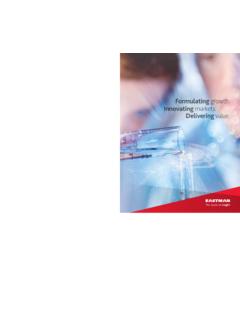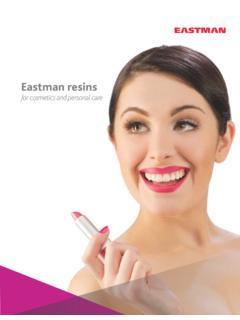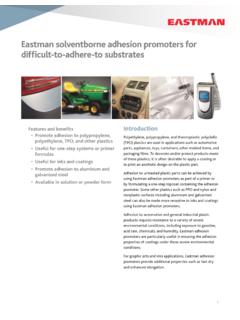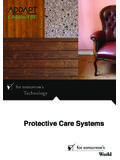Transcription of Eastman chlorinated polyolefins
1 1 Eastman chlorinated polyolefinsFormulating with Eastman waterborne CPO adhesion promotersUseful as: Base resins for waterborne adhesion promoter primers Adhesion promoting additives for waterborne coatingsIntroductionThe application of paint to polypropylene and TPO (thermoplastic polyolefin) is difficult because of the poor adhesion of most coatings to these plastics. Eastman CPO adhesion promoters are effective in improving paint adhesion to these substrates. With Eastman CPO dispersions, it is possible to apply an adhesion-promoting primer from a waterborne system or to promote adhesion of a waterborne coating through use as an additive. Physical propertiesEastman CP 310W, CP 347W, and CP 349W are water dispersions of the same CPO resin.
2 Major differences are the neutralizing amine in each dispersion and the presence of ethylene glycol in CP 349W. Physical properties are shown in Table 1 Typical propertiesaEastman CP 310 WEastman CP 347 WEastman CP 349 WWt% solids302526Wt% CPO242020 Solvent 5% ethylene glycolpH @ 25 C9 109 109 10 AmineAmmonia2-amino- 2-methyl- 1-propanol2-amino- 2-methyl- 1-propanolStabilityShelf, 1 yrNo changeNo changeNo change50 C, 4 wkSlight settleNo changeNo changeFreeze-thawGoodGoodGoodaEastman makes no representation that product in any particular shipment will conform exactly to the values listed. Generally, the faster evaporating ammonia in CP 310W makes it more useful in adhesion-promoting primers that are air dried prior to application of the topcoat.
3 The 2-amino-2-methyl-1-propanol in CP 347W and CP 349W makes them more compatible with other waterborne resins and therefore more useful as additives. However, there are exceptions to these generalizations, depending on the other components of the substrate/coating system. Use as primersEastman CPO dispersions are useful as the base resin in adhesion-promoting primers. Primer performance with various topcoat systems is shown in Figure 1. This data shows that primer performance is generally comparable to that of solventborne chlorinated polyolefinsFormulating with Eastman waterborne CPO adhesion promoters (Continued}Figure 1 Humidity resistance of CPO primersa,b % Retained adhesion010203050607080900050040030020% AdhesionHoursSystem 9 System 1 8 System 10 System 11 System 1210010040 SystemPrimerdBlisterseTime, h1 PEBCCP 343-1 2CP 310W10F1683CP 347W 4CP 349W 5 WBBCCP 343-110F1686CP 310W10F1687CP 347W 8CP 349W10F16892 KPURCP 343-1 10CP 310W8M7111CP 347W 10F7212CP 349W10F71a50 C Cleveland humidity resistance (ASTM D4585).)
4 Substrate: Basell 3131 thermoplastic primer reduced to 5% 10% CPO, spray-applied to give a 5 10 micron dry film thickness, and dried 6 h @ 25 C. Topcoats were spray-applied and dried as directed. Data is mean % retained adhesion (ASTM D3359B), for 3 replicate panels after indicated duration in = OEM metallic polyester basecoat/clearcoat, baked for 20 min @ 127 C. WBBC = OEM waterborne basecoat/acrylic clearcoat, baked for 20 min @ 127 C. 2 KPUR = OEM 2K elastomeric polyester urethane, baked for 30 min @ 80 343-1 control applied as 5% solution in toluene. CPO dispersions reduced 1 part dispersion/2 parts water prior to size and density per ASTM D714.
5 Time indicates point in test at which blisters chlorinated polyolefinsFormulating with Eastman waterborne CPO adhesion promoters (Continued}Primer formulationsTo be an effective adhesion-promoting primer, the CPO film layer should be about 3 5 microns thick. CPOs are soft materials, and if the primer layer is too thick, it will tear apart, resulting in what appears to be an adhesion failure but is actually a cohesive failure. To achieve proper film thickness in a spray application, the CPO dispersion is usually reduced to 5 10 wt% solids prior to , CPO dispersion primers are formulated to help the waterborne system wet out the plastic and to reduce foam.)
6 Note that defoamers and additives that promote wet-out can sometimes reduce adhesion-promoting performance. This can be seen with the heavier alcohols in Table 2. Some glycol ether solvents can adversely affect adhesion, even though they appear to improve substrate 2 Effect of alcohols and defoamers on Eastman CP 310W, foaming tendency and adhesion performance % Retained adhesionbAlcohol/defoamer Wt%aFoamingPPcTPOdNone Severe100100 Eastman n-propyl alcohol20 Moderate100100 Eastman n-butyl alcohol10 Slight100100 Eastman isobutyl alcohol5 Moderate10010010 None100100 Eastman methyl amyl alcohol5 None6020010 None050 Eastman 2-ethylhexyl alcohol5 Moderate4010010 Moderate dispersion gelled BYK 22 23 24 25 33 45 on total weight of CP homopolymer 3131 thermoplastic was added and CP 310W was shaken by 310W reduced 1 part CP 310W to 2 parts water, spray applied to give a 5-micron dry-film thickness, dried 6 h @ 25 C.
7 Topcoat is OEM metallic polyester basecoat/acrylic clearcoat, baked 30 min @ 121 C. 4 Some higher molecular weight solvents can also adversely affect hot box stability if present at too high a concentration. It is suggested that any materials added to the CPO dispersion to aid wet-out or coalescence or to reduce foam be evaluated for their effect on adhesion-promoting performance and 3 A, B, and C show suggested starting-point waterborne primer formulations for polypropylene substrates. These may be used to construct formulations to meet specific needs. The purpose of the polyurethane thickening agent in the formulation shown in Table 3 C is to allow the coating to sit on the substrate during solvent and water evaporation with minimal drawback.
8 Other types of thickeners may also be used. The use of a thickener may allow for less use of solvents as wetting agents. Thickening agents should be diluted and added with agitation for best formulation stability. Table 3 waterborne primer formulations for polypropylene substrates(A)SubstrateWt% Eastman CP 310W, CP 347W, or CP 349W.(B)SubstrateWt%Wt% Eastman CP dispersiona EEH Texanol ester-alcohol 310W, CP 347W, or CP 349W. When using CP 310W, these formulations may have poor stability after long storage (>200 h @ 50 C).(C)SubstrateWt% Eastman CP dispersiona DSX-1514 polyurethane thickener 22 water 310W, CP 347W, or CP : Dilute the DSX-1514 in some or all of the water and add it under chlorinated polyolefinsFormulating with Eastman waterborne CPO adhesion promoters (Continued}5 Use as additivesEastman CPO dispersions can be added directly to waterborne coating formulations to improve adhesion to polypropylene-based substrates.)
9 Generally all three dispersions are compatible with most preneutralized dispersion resins. CP 347W and CP 349W are also compatible with many amine-neutralizable solution resins. All three CPO dispersions improve adhesion of many acrylic dispersion resins. Of the three, CP 349W provides Eastman chlorinated polyolefinsFormulating with Eastman waterborne CPO adhesion promoters (Continued}Table 4 Resin compatibility and retained adhesionaCompatibility 0% CPO% Retained adhesion on PP% Retained adhesion on TPO Resinb Type CP 10W CP 347W CP 349W10% CP 310W10% CP 347W10% CP 349W0% CPO10% CP 310W10% CP 347W10% CP 349 WDispersion resinsNeocryl XA5090 AcrylicCCC0801001000100100100 Neocryl XA601510000000 Neocryl A612100100100100 Neocryl A62350100 Joncryl 53000000 Joncryl 537100 Rhoplex CL-104100501004010050WL92040100100 Rhoplex CL-10100070HP5035 Urethane01080100HP10350505050 Neorez R9600000 NeoPac)
10 R-90001010080100100XP70280000XP701580100 100 Urotuf L500 Witcobond W23620 Witcobond W4010 Solution resinscChempol 31-1744 AcrylicINCCC0 1001000 100100WR97 Aquamac 1610 AlkydINC 50 Mirasol 02A4603C100100100 Legend: C = Compatible INC = Incompatible PP = P4G42-011 polypropylene homopolymer TPO = Himont 3131 thermoplastic olefinaCPO dispersions were added to resins to give 10% CPO based on resin listed on page were neutralized with amine in CPO dispersion: ammonium hydroxide for CP 310W; AMP-95 for CP 347W and CP 349W. the best performance with polyurethane dispersion resins. CP 310W is generally not useful as an additive to polyurethane dispersion resins.















